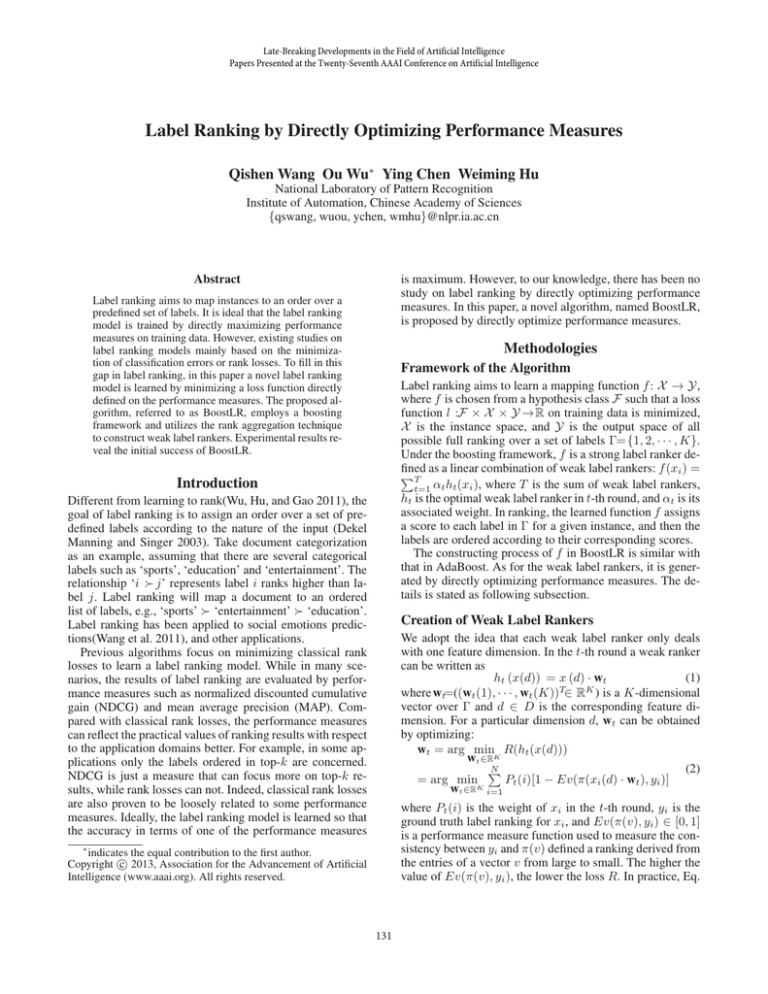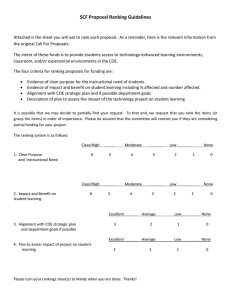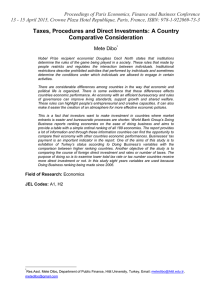
Late-Breaking Developments in the Field of Artificial Intelligence
Papers Presented at the Twenty-Seventh AAAI Conference on Artificial Intelligence
Label Ranking by Directly Optimizing Performance Measures
Qishen Wang Ou Wu∗ Ying Chen Weiming Hu
National Laboratory of Pattern Recognition
Institute of Automation, Chinese Academy of Sciences
{qswang, wuou, ychen, wmhu}@nlpr.ia.ac.cn
Abstract
is maximum. However, to our knowledge, there has been no
study on label ranking by directly optimizing performance
measures. In this paper, a novel algorithm, named BoostLR,
is proposed by directly optimize performance measures.
Label ranking aims to map instances to an order over a
predefined set of labels. It is ideal that the label ranking
model is trained by directly maximizing performance
measures on training data. However, existing studies on
label ranking models mainly based on the minimization of classification errors or rank losses. To fill in this
gap in label ranking, in this paper a novel label ranking
model is learned by minimizing a loss function directly
defined on the performance measures. The proposed algorithm, referred to as BoostLR, employs a boosting
framework and utilizes the rank aggregation technique
to construct weak label rankers. Experimental results reveal the initial success of BoostLR.
Methodologies
Framework of the Algorithm
Label ranking aims to learn a mapping function f : X → Y,
where f is chosen from a hypothesis class F such that a loss
function l :F × X × Y →R on training data is minimized,
X is the instance space, and Y is the output space of all
possible full ranking over a set of labels Γ={1, 2, · · · , K}.
Under the boosting framework, f is a strong label ranker defined as a linear combination of weak label rankers: f (xi ) =
PT
t=1 αt ht (xi ), where T is the sum of weak label rankers,
ht is the optimal weak label ranker in t-th round, and αt is its
associated weight. In ranking, the learned function f assigns
a score to each label in Γ for a given instance, and then the
labels are ordered according to their corresponding scores.
The constructing process of f in BoostLR is similar with
that in AdaBoost. As for the weak label rankers, it is generated by directly optimizing performance measures. The details is stated as following subsection.
Introduction
Different from learning to rank(Wu, Hu, and Gao 2011), the
goal of label ranking is to assign an order over a set of predefined labels according to the nature of the input (Dekel
Manning and Singer 2003). Take document categorization
as an example, assuming that there are several categorical
labels such as ‘sports’, ‘education’ and ‘entertainment’. The
relationship ‘i j’ represents label i ranks higher than label j. Label ranking will map a document to an ordered
list of labels, e.g., ‘sports’ ‘entertainment’ ‘education’.
Label ranking has been applied to social emotions predictions(Wang et al. 2011), and other applications.
Previous algorithms focus on minimizing classical rank
losses to learn a label ranking model. While in many scenarios, the results of label ranking are evaluated by performance measures such as normalized discounted cumulative
gain (NDCG) and mean average precision (MAP). Compared with classical rank losses, the performance measures
can reflect the practical values of ranking results with respect
to the application domains better. For example, in some applications only the labels ordered in top-k are concerned.
NDCG is just a measure that can focus more on top-k results, while rank losses can not. Indeed, classical rank losses
are also proven to be loosely related to some performance
measures. Ideally, the label ranking model is learned so that
the accuracy in terms of one of the performance measures
Creation of Weak Label Rankers
We adopt the idea that each weak label ranker only deals
with one feature dimension. In the t-th round a weak ranker
can be written as
ht (x(d)) = x (d) · wt
(1)
where wt=((wt (1), · · · , wt (K))T∈ RK ) is a K-dimensional
vector over Γ and d ∈ D is the corresponding feature dimension. For a particular dimension d, wt can be obtained
by optimizing:
wt = arg min R(ht (x(d)))
wt ∈RK
N
(2)
P
= arg min
Pt (i)[1 − Ev(π(xi (d) · wt ), yi )]
wt ∈RK i=1
where Pt (i) is the weight of xi in the t-th round, yi is the
ground truth label ranking for xi , and Ev(π(v), yi ) ∈ [0, 1]
is a performance measure function used to measure the consistency between yi and π(v) defined a ranking derived from
the entries of a vector v from large to small. The higher the
value of Ev(π(v), yi ), the lower the loss R. In practice, Eq.
∗
indicates the equal contribution to the first author.
c 2013, Association for the Advancement of Artificial
Copyright Intelligence (www.aaai.org). All rights reserved.
131
Table 1: The NDCG values of the competing algorithms on UCI data sets.
Data set
authorship
bodyfat
calhousing
cpu-small
elevators
fried
housing
stock
vowel
wine
Avg. Rank
NDCG-1
IB-PL
IB-Mal
.7009
.3671
.3129
.3117
.4702
0.4201
.4198
.3657
.3641
.2161
.4987
.3640
.3203
.3326
.5841
.3571
.2519
.1901
.7520
.4695
2.438
3.189
BoostLR
.8044
.3577
.5583
.4698
.4739
.5100
.3840
.5722
.3478
.9045
1.375
Lin-LL
.5068
.2323
.4814
.4246
.2833
.3659
.3351
.3167
.1936
.7472
3
BoostLR
.7879
.4825
.6279
.5789
.5457
.6189
.5316
.6096
.4938
.8367
1.5
NDCG-2
IB-PL
IB-Mal
.8661
.4708
.4466
.4268
.5806
0.5409
.5217
.4522
.4864
.3230
.5778
.4576
.4453
.4783
.6545
.4563
.3441
.2725
.7645
.5685
2.375
3.188
Lin-LL
.6130
.3848
.5831
.5246
.3623
.4598
.4687
.5148
.2888
.7655
2.938
BoostLR
0.8743
.5887
0.7223
.6691
.6718
.7021
.6774
.7005
.5735
.9372
1.5
NDCG-3
IB-PL
IB-Mal
.8867
.6174
.5697
.5424
.6982
0.6574
.6182
.5422
.5942
.4258
.6513
.5500
.6007
.6263
.7076
.5448
.4130
.3628
.8898
.7897
2.375
3.25
Lin-LL
.7343
.5192
.6996
.6202
.4600
.5515
.6379
.5708
.3474
.8890
2.875
Algorithm 1 Creating ht in the t-th round
(2) is intractable to directly optimized as the search space
of wt is RK and the performance measures (e.g., NDCG)
are usually non-continuous. We instead introduce a nearoptimal search procedure as follows.
0
00
0
For any two parameter vectors wt and wt , if π(wt ) =
00
π(wt ), their corresponding weak learners’ performances are
equal. Hence, the search space of Eq. (2) is reduced to
K! as Ev is only sensitive to π(wt ). Note that if xi (d)≥
0, π(xi (d) · wt ) = π(wt ) and if xi (d) < 0, π(xi (d) · wt ) =
Inver(π(wt )), where Inver(π) is the ranking by reversing
π. Then the Eq.(2) is equivalent
P to
wt = arg max {
Pt (i)Ev[π(wt ), yi ]
wt ∈RK i,xi (d)≥0
P
(3)
+
Pt (j)Ev[Inver(π(wt )), yj ]}
Input: Samples S = {(x1 , y1 ), · · · , (xN , yN )}, Pt ;
Output: Weak label ranker ht .
1: Initialize w(d) = 0, d = 1, · · · , D;
2: for (int d = 1; i ≤ D; d + +) do
3:
for (int i = 1; i ≤ N ; i + +) do
4:
Calculate y i using Eq. (5)
5:
w(d) = w(d) + Pt (i) [1K×1 − y i ]
6:
end for
7:
Normalizing w(1) , · · · , w(D) to [0, 1];
N
P
(d)
8:
Calculate Et =
Pt (i)Ev(π[xi (d)w(d) ], yi )
i=1
9: end for
(d)
10: Find d such that Et is the maximum and return d and wt .
j,xj (d)<0
When K is small, wt can be achieved by a simple strategy
that calculates all the K! possible rankings in RK . However,
when K is large, this simple strategy is inapplicable. If Ev is
taken as a measure of the consistency between two rankings,
Eq. (3) can be approximately
Ptransformed into:
wt = arg max
Pt (i)Ev[π(wt ), yi ]
wt ∈RKi,xi (d)≥0
P
(4)
+
P (j)Ev[π(wt ), Inver(yj )]
Hüllermeier 2009), and Lin-LL proposed by (Dekel Manning and Singer 2003). As the initial experiments, NDCG is
used to construct Ev and measure the performances of the
competing algorithms. In the calculation of NDCG for a particular data set, if the number of labels is smaller than six,
NDCG@1, NDCG@2, and NDCG@3 are calculated; otherwise, NDCG@1, NDCG@3, and NDCG@5 are calculated.
For convenience, the three NDCG values are called NDCG1, NDCG-2, and NDCG-3. Each algorithm is performed 5fold cross validation and the average results are reported.
As the limited space, only the results on partial UCI data
sets are shown in Table 1. A two-step procedure recommended in (Demsar 2006) is used to compare the performance between each pair of algorithms. The comparison is
based on the average ranks. At a level of 5%, BoostLR outperforms all the other competing algorithms.
j,xi (d)<0
Let
y (i) =
yi
Inver(yi )
Then Eq.(4) equals to
wt = arg max
wt
∈RK
N
P
if xi (d) ≥ 0
if xi (d) < 0
Pt (i)Ev(π(wt ), y i )
(5)
(6)
i=1
Eq.(6) aims to find an optimal ranking (π(wt )) that is consistent with all the N rankings (yi ) as much as possible. This
is a typical rank aggregation problem. The weighted linear
combination method (Lee 1997) is considered here.
Algorithm 1 shows the process of creating weak label
ranker. It is noteworthy that more than one weak ranker
would likely be generated in the algorithm. In this case, the
ht that makes the performance of current ft maximize will
be chosen as the optimal weak ranker.
Conclusions
This paper has proposed a novel algorithm called BoostLR
for label ranking. BoostLR can directly optimize the performance measures instead of optimizing either the pairwise
ranking errors or rank losses that existing studies focus on.
Initial experiments show that BoostLR outperforms several
state-of-the-art label ranking algorithms.
Experiments
Acknowledgements
Sixteen UCI data sets compiled by (Cheng, Dembczynski and Hüllermeier 2010) are used in our experiments.
Three existing state-of-the-art algorithms used in the experiments are: IB-PL proposed by (Cheng, Dembczynski
and Hüllermeier 2010), IB-Mal proposed by (Cheng and
This work is partly supported by the NSFC (No. 61003115
and 60935002), the National 863 High-Tech R&D Program
of China (No. 2012AA012504), the Natural Science Foundation of Beijing (No. 4121003), and Guangdong Natural
Science Foundation (No. S2012020011081).
132
References
Cheng, W.; Dembczynski, K.; and Hüllermeier, E. 2010. Label Ranking Methods based on the Plackett-Luce Model. In
Proc. Int. Conf. on Machine learning (ICML): 215-222.
Dekel, O.; Manning, C. D.; and Singer, Y. 2003. Log-linear
models for label ranking. In: Advances in Neural Information Processing Systems (NIPS) 16.
Wu, O.; Hu, W. M.; and Gao, J. 2011. Learning to Rank
under Multiple Annotators. In Proc. International Joint Conference on Artificial Intelligence, 1571-1576.
Cheng, W., and Hüllermeier, E. 2009. A New InstanceBased Label Ranking Approach Using the Mallows Model.
International Symposium on Neural Networks (1): 707 -716.
Demsar, J. 2006. Statistical comparisons of classifiers over
multiple data sets. Journal of Machine Learning Research
(JMLR), 7:1-30.
Wang, Q. S.; Wu, O.; Hu, W. M.; Li, W. Q.; and Yang, J. F.
2011. Ranking Social Emotions by Learning Listwise Preference. Asian Conference on Pattern Recognition, 164-168.
Lee, J. H. 1997. Analyses of multiple evidence combination.
In Proc. ACM SIGIR Conference on Research and Development in Information Retrieval Conference, 267-276.
133




